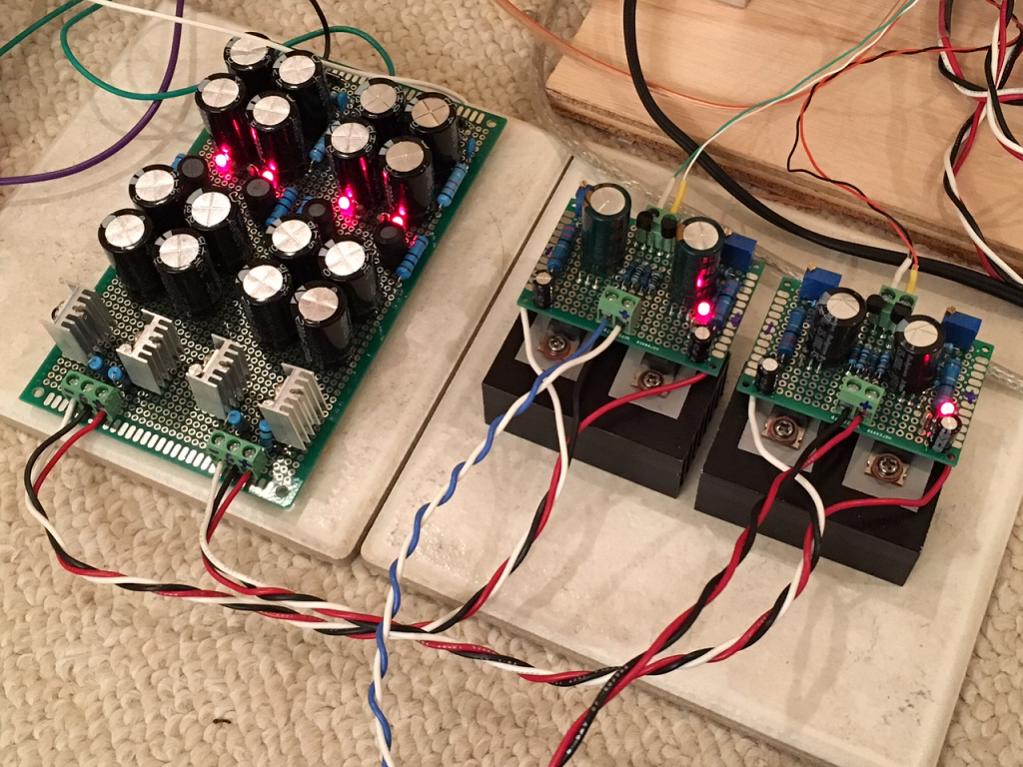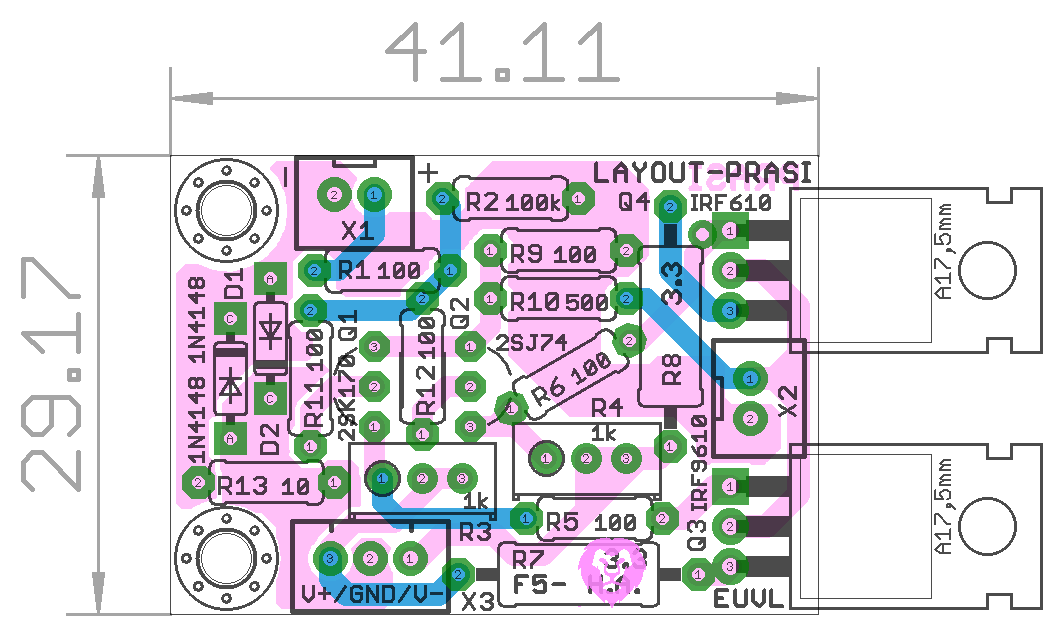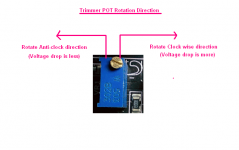Its hard to find equal heights between SMT and TH caps, SMD rarely go above 13mm in height. The apparently restricted heights may well be part of the reason the ESRs are inferior. Lifetime is normally inferior too.
I notice a very impressive new range from Nichicon, amazing density to reach 1000uF/25V in a 10*10 can size : http://www.mouser.com/ProductDetail/Nichicon/UCV1E102MNL1GS/?qs=sGAEpiMZZMtZ1n0r9vR22YDsfh7SCQ5qonGx%252buX53irIlYInr4roeg%3d%3d
I notice a very impressive new range from Nichicon, amazing density to reach 1000uF/25V in a 10*10 can size : http://www.mouser.com/ProductDetail/Nichicon/UCV1E102MNL1GS/?qs=sGAEpiMZZMtZ1n0r9vR22YDsfh7SCQ5qonGx%252buX53irIlYInr4roeg%3d%3d
Last edited:
1000uF 25v in a 10mm x 10mm SMT is indeed very impressive. This could really be used for some compact PSU's on my next head amp project. Although, the $2 ea price is a bit of sticker shock.
I am looking for a way to shrink that PSU board on the left. Each of those is a 2200uF cap and to get the low level (sub 1mV ripple) filtering I need, I need lots of milliFarads.

This is an F5 class A headamp - sounds wonderful. Sorry, not class D, but let met tell you this: it sounds better than any head amp I have ever heard. Absolutely silent, no distortion, dynamic, clear and detailed.
http://www.diyaudio.com/forums/pass-labs/271926-f5-headamp-80.html
Btw, anyone interested in making this, you can veroboard it easily enough (4 transistors and a few resistors), or use the new PCB layout from Prasi:

I am looking for a way to shrink that PSU board on the left. Each of those is a 2200uF cap and to get the low level (sub 1mV ripple) filtering I need, I need lots of milliFarads.

This is an F5 class A headamp - sounds wonderful. Sorry, not class D, but let met tell you this: it sounds better than any head amp I have ever heard. Absolutely silent, no distortion, dynamic, clear and detailed.
http://www.diyaudio.com/forums/pass-labs/271926-f5-headamp-80.html
Btw, anyone interested in making this, you can veroboard it easily enough (4 transistors and a few resistors), or use the new PCB layout from Prasi:

Last edited:
I like those pcb's you are using.....
I have them in different sizes, too.
The quality is unbeatable for the prizes.
Never had a single wrecked solder pad / hole on one of them.
I like those pcb's you are using.
I have them in different sizes, too.
The quality is unbeatable for the prizes.
Never had a single wrecked solder pad / hole on one of them.
They are indeed fantastic quality and prices. About $4 for 10 of the 4x6cm ones. Although a custom 2-sided 50mm x 50mm PCB is now only $6, and 10cm x 10cm is $10 (not including shipping which is about $14).
I only had a solder pad come off because I was drilling it out to fit a bigger pin in. I think it is "2oz" thick copper pads.
1000uF 25v in a 10mm x 10mm SMT is indeed very impressive. This could really be used for some compact PSU's on my next head amp project. Although, the $2 ea price is a bit of sticker shock.
I had a quick look on Taobao for sellers of that part, the lowest price I found was around $0.55.
This may well be going way off-topic but you want the PSU to occupy less physical volume? Or is there another meaning to 'shrink' you intended? Looks from eyeballing it you may have some smallish bobbin-wound chokes on there but to reduce the requirement for capacitance in reducing mains ripple you'd need to go to having more significant series inductance I reckon. Or another way would be to use higher voltage caps (because they store more energy per unit volume) but then you'd need an output transformer which itself is bulky. But perhaps you could locate the transformer somewhere where bulk isn't an issue?I am looking for a way to shrink that PSU board on the left. Each of those is a 2200uF cap and to get the low level (sub 1mV ripple) filtering I need, I need lots of milliFarads.
I'm currently working on a very low ripple PSU for another DIYer's classA amp (around 30W per channel) and the solution there is using gapped PQ35 ferrite cores as series inductors (several 10s of mH each). However these inductors are fairly bulky.
Save
Last edited:
I mean volume wise so I can stuff it into typical smallish aluminum enclosure such as 2107 sold on eBay/Aliexpress. The amp bias current is 100mA and this is well below the 1A rating on the 1mH inductors - yes, I know they may saturate but seems to be doing a good job thus far. The ripple coming out of the 7815/7915 regulators is sub mV. There is absolutely no hum or noise/hiss on the head amp when music is turned off.
But today is 2016 !! Times are changing. High reliability, ultra low ESR, high temperature and long life caps in SMT/SMD form are available. Even all features combined and there is no tantalum in them.
http://industrial.panasonic.com/ww/products/capacitors/polymer-capacitors/poscap
http://industrial.panasonic.com/ww/products/capacitors/polymer-capacitors/poscap
Last edited:
I have four of the Sanwu blue 3118s in a pair of FAST speakers. The 8 inch woofers are 4ohm impedance.
I want to lower the gain.... (I can can finds the posts and piccies in this thread to show how to do that).
However, I am concerned that there have been comments about the Sanwu 3118 "lacking bass" or having "lower bass levels". Would adding an LPAD to the woofer to bring the impedance up to 8ohms do much to help?
Hmmmm, I think I don't have a problem. I'm only using the "bass" amps for up to 200HZ. And I already deal with the woofer being 4ohm by knocking off 3dB in Linux. Using the laptop to plot test tones in REW earlier showed a flat-ish response from 40hz to 60hz. The mobile phone apps will be getting binned unless that Dayton mini-mic is worth the few dollars?!?
The electrics are "modular".... In that they're all screwed to a flat piece of 1.2mm Alu. At some point I might throw another £20-£40 at eBay and try swapping the amps for TDA8932s or even "ordinary" TPA3116s.
Hi ,
our TPA3116/18 standalone amp is ready.
http://www.allo.com/marketing/brochures/allo-volt-plus-brochure.pdf
It has all mods incorporated...in adition we have a capacitance multiplier on board that will allow any "crappy" psu to be less than 10mV (since psrr of tpa3118 its mediocre at best)
We are looking for 5 people to try "free of charge" the amp , provided that you are very active on diy forums and you can show you have an interest in tpa3116/18 amps
We only request unbiased review on SQ of our amp.
In exchange for a review CDGAMES sent me the Allo Volt+ amp. I received it a few days ago. I already told CDGAMES that I cannot write a technical review because I am not a technical person. What I can write is my personal experience with the Volt+ amp.
A few years ago I discovered the Class D amp. I bought a Tripath amp (2021 Indeed Hifi) for my study room and I liked it. After reading many pages in audioforums I bought a SMSL SA-60 amp (TPA3116). I liked it much more than my Tripath amp and I gave the Tripath amp to a friend.
After a few months I exchanged the laptop power supply for a linear power supply (Delta Elektronica M24-12HE. In the Netherlands, where I live, they are not as expensive as on ebay).
The 24V linear power supply had a big impact on the sound. In my opinion everything was better.
After enjoying the SMSL/Delta combination for a year or so, I read about the TPA3118 Sanwu monoboards. I ordered two, connected them (unmodded) with the Delta Elektronika PS and the Iqaudio Dac and I couldn’t stop listening. It was so captivating. I listened to this combination for half a year.
Then I read about the Volt+. CDGAMES sent me one. The board is quite heavy and soldering is good. I started to listen together with a friend (who has a technical background). We connected the Volt+ to the Delta Elektronika PS and the Raspberry Pi Zero/ IQaudio (we used three batteries, 5V, 5V, 3,3V) and my B&W DM5 speaker. We started to listen.
We listened to:
-Nathalie Merchant
-Tracy Chapman
-Lucy Ward
-Youn Sun Nah – Album: Lento
-Steven Bernstein – Album: Diaspora Soul
It was ok. There was no hiss when we paused the music. The sound was detailed, powerful, stereo-image was ok, middle notes were ok. But the high and low notes were not very good, muddy, and female voices were not captivating. Don’t understand me wrong, it was not bad, but it was, in our opinion, worse than the Sanwu monoboards. It was not very musical. After half an hour we wanted to stop listening.
Then I thought: Well the Volt+ has a Capacitance Multiplier so may be it’s a good idea to exchange the Delta Elektronika 24V Linear PS for a laptop PS. That’s what I did and what a difference it made! We listened the same songs and more and more. How does this song sound on the Volt+? And this song? Female voices were terrific.
In our opinion, the laptop PSU made the Volt+ better in every way. I will try to describe the sound, realizing it’s very difficult and subjective to describe a sound in words!
There is space between the instruments. It’s not muddy or woolly. It’s transparent. The high notes are clean. 3D imaging is good. Beautiful bass. The sound is quiet (probably the wrong word in English) and in control. The sound is detailed (not too much, exactly good) and dynamic.
We listened to Youn Sun Nah (Empty Dream from the album Lento) and it was breath-taking! Never heard it so! We listened to Steven Bernstein (L’Chaim from the album Diaspora Soul – it is one of my favourite albums). Perfect, completely in control, detailed, dynamic. We listened to the new Leonard Cohen single Want it darker (the only song we listened on Spotify). We never heard it more beautiful!
At the end of our listening session we gave marks:
Sanwu monoboards (unmodded) with 24V Linear PS – 7,5 (on a scale from 1-10)
Volt+ with 24V Linear PS – 6,5 (on a scale from 1-10)
Volt+ with 19V laptop PS – 9,0 (on a scale from 1-10)
We listened much more than we planned. And to summarize my/our experience: This is a very musical Amp. That my friend also wants to buy one says enough….
Last edited:
Hello ,
glad you like the Volt+
Regarding the linear PSU, do you have any measuring of the ripple ? The CM has to have a higher dropout voltage than the ripple/noise. I suspect that your PSU has higher ripple than 0.5V so CM is not able to clean it.
We do have a trim pot on the CM , so you can adjust the dropout voltage further. I will post some info shortly
glad you like the Volt+
Regarding the linear PSU, do you have any measuring of the ripple ? The CM has to have a higher dropout voltage than the ripple/noise. I suspect that your PSU has higher ripple than 0.5V so CM is not able to clean it.
We do have a trim pot on the CM , so you can adjust the dropout voltage further. I will post some info shortly
At the end of our listening session we gave marks:
Sanwu monoboards (unmodded) with 24V Linear PS – 7,5 (on a scale from 1-10)
Volt+ with 24V Linear PS – 6,5 (on a scale from 1-10)
Volt+ with 19V laptop PS – 9,0 (on a scale from 1-10)
We listened much more than we planned. And to summarize my/our experience: This is a very musical Amp. That my friend also wants to buy one says enough….
Sanwu without the CM !! can handle the external ripple better ?
YJBB that comes standard with "wrong' filmtype bootstrap capacitors and distant GVDD capacitor can't handle low impedances (that improves too when lowering PSU voltage), listening to that ampboard has same "muddy" treble experience, there replacing the bootstrap filmcaps for stacked film or ceramic and putting GVDD cap close to pin makes main difference. So it might not be the fake Panasonics on the Volt+
YJBB that comes standard with "wrong' filmtype bootstrap capacitors and distant GVDD capacitor can't handle low impedances (that improves too when lowering PSU voltage), listening to that ampboard has same "muddy" treble experience, there replacing the bootstrap filmcaps for stacked film or ceramic and putting GVDD cap close to pin makes main difference. So it might not be the fake Panasonics on the Volt+
Can somebody please summaries the mods i should consider for this application:
Sanwu TPA3118 glued to the backside of a big 100+ db horn driver.
Plays only 1.5kHz and above frequencies.
I managed to reduce the noise of the active x-o unit in front of it.
Now i want to squeeze out every bit of sound quality i can get out of it.
Sanwu TPA3118 glued to the backside of a big 100+ db horn driver.
Plays only 1.5kHz and above frequencies.
I managed to reduce the noise of the active x-o unit in front of it.
Now i want to squeeze out every bit of sound quality i can get out of it.
The Panasonic capacitor is not fake.
Its not about the Sanwu handling the ripple better...is about V dropout of CM versus the ripple .. I suspect thats what creates the problem
Its not about the Sanwu handling the ripple better...is about V dropout of CM versus the ripple .. I suspect thats what creates the problem
Sanwu without the CM !! can handle the external ripple better ?
. So it might not be the fake Panasonics on the Volt+
Hi ,
I have attached the trimmer on Volt+. This will make the CM drop the voltage (at maximum) to about 1.4v. By default we drop 0.3v
If you have any problem with the sound please adjust the trimpot.
The dropout voltage of CM has to be higher than PSU ripple/noise.
I have attached the trimmer on Volt+. This will make the CM drop the voltage (at maximum) to about 1.4v. By default we drop 0.3v
If you have any problem with the sound please adjust the trimpot.
The dropout voltage of CM has to be higher than PSU ripple/noise.
Attachments
The Volt(+) marketing brochures box the two electrolytics and label them Panasonic. The electrolytics in the marketing brochures that are labelled Panasonic are 100% certain NOT Panasonic.
Sanwu HF: 0805 (or smaller if you dare) cog 330pF vertical on C32&C16, 10 ohm resistor same size vertical on C15&C39, connected to eachother not on pcbside (bootstrapsnubber)
replace the inputcapacitors c41/c21 for cogs (you don't need 4uF for 1500Hz)
reduce gain
replace the 4 electrolytics (originally 160mOhm impedance which can be reduced substantially) for solid polymer (you don't need 660uF per side for >1500Hz)
Replace inductors for decent ones considering the speaker impedance and the 1uF capacitor that goes to gnd that is the other part of Sanwu filter
-one can try to add >2uF ceramics for PVCC-GND decoupling next to c15/c39
Sanwu HF: 0805 (or smaller if you dare) cog 330pF vertical on C32&C16, 10 ohm resistor same size vertical on C15&C39, connected to eachother not on pcbside (bootstrapsnubber)
replace the inputcapacitors c41/c21 for cogs (you don't need 4uF for 1500Hz)
reduce gain
replace the 4 electrolytics (originally 160mOhm impedance which can be reduced substantially) for solid polymer (you don't need 660uF per side for >1500Hz)
Replace inductors for decent ones considering the speaker impedance and the 1uF capacitor that goes to gnd that is the other part of Sanwu filter
-one can try to add >2uF ceramics for PVCC-GND decoupling next to c15/c39
Sanwu HF: 0805 (or smaller if you dare) cog 330pF vertical on C32&C16, 10 ohm resistor same size vertical on C15&C39, connected to eachother not on pcbside (bootstrapsnubber)
replace the inputcapacitors c41/c21 for cogs (you don't need 4uF for 1500Hz)
reduce gain
replace the 4 electrolytics (originally 160mOhm impedance which can be reduced substantially) for solid polymer (you don't need 660uF per side for >1500Hz)
Replace inductors for decent ones considering the speaker impedance and the 1uF capacitor that goes to gnd that is the other part of Sanwu filter
-one can try to add >2uF ceramics for PVCC-GND decoupling next to c15/c39
Thanks for the summary.
- Home
- Amplifiers
- Class D
- Cheap TPA3118D2 boards, modding them and everything that comes with it
